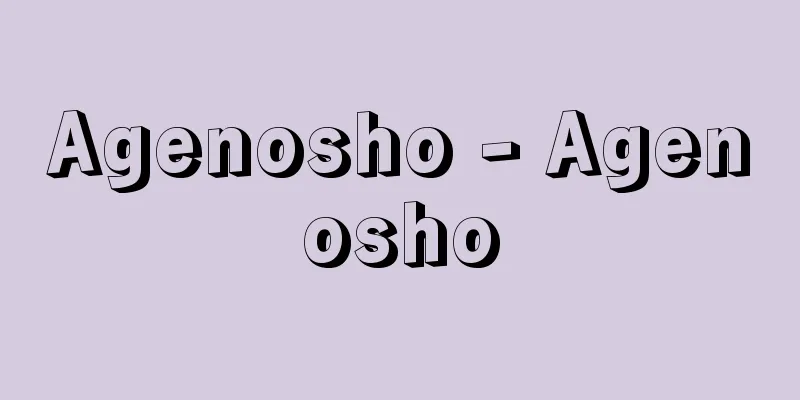Closed Country - Sakoku

|
Generally speaking, the term "sakoku" refers to the state of international isolation that arose when the feudal state of early modern Japan tried to establish its rule and thoroughly suppress Christianity, which was incompatible with the state, by severely restricting and restricting diplomacy, foreign communication, and trade. In addition, the policies, especially the legal measures, that the shogunate implemented for the above-mentioned purpose are commonly referred to as "sakoku ei" (national isolation edicts). [Tsuda Hideo] Center of the National Isolation OrderThe main part of this legal measure was the prohibition of Christianity, which (1) prohibited the preaching and practice of Christianity within the country for both domestic and foreign nationals, (2) prohibited not only the possession but even contact with literature and implements that could be suspected to be in any way related to Christianity, (3) prohibited Japanese from traveling abroad in order to prevent the introduction of Christianity from overseas, (4) limited the gate of foreign traffic and trade to the port of Nagasaki alone, restricted the residence of foreigners to the same port, and prohibited domestic travel in principle, and (5) prohibited trade with and arrival by sea from the people of Spain and Portugal, which had close ties to the spread of Christianity. It is important to note that, in terms of trade, this prohibition did not prohibit the arrival or trade of people from other countries besides these two countries. In reality, however, only trade by Chinese and Dutch people and trade with Koreans via Tsushima continued, and in the late early modern period, all foreign countries except the Netherlands, China, and Korea became subject to the isolation order, which came to be understood as a country being closed off to these countries. On the other hand, when we consider the opening of the country as a result of national isolation, the ban on Christianity, which was the most important issue during the several periods of national isolation between 1633 (Kan'ei 10) and 1639 (Kan'ei 16), was still enforced even after the country was opened, and it was not resolved until several years after the establishment of the Meiji government. Furthermore, after the country was opened, free trade was not permitted in all areas. In other words, with regard to rice, which is most closely related to the kokudaka system, the social foundation of the early modern state, in principle it was not possible to export it to or import it from abroad, no matter how high or low the price of rice rose or fell, just as it had been under the national isolation system. It was not until the Meiji government was established that the ban on this point was lifted. This shows that understanding national isolation does not simply mean closing off the country from the world in order to ban Christianity. [Tsuda Hideo] The role of national isolationHere, let us once again examine the various theories about the role played by national isolation. The first is that national isolation was implemented in order for the shogunate to thoroughly enforce its centralized early modern feudal rule, and to eliminate anti-shogunate forces that were in danger of forming political or military alliances with Christians, who were incompatible with national isolation. In particular, the Shimabara-Amakusa Rebellion provided the pretext for implementing this policy. The second view is from the Dutch perspective, and is that Japan was forced into the isolationist system as part of the Dutch commercial capital's conquest of Oriental trade. This was done to threaten the trade routes to Japan of Portugal and Spain, which had advanced into the Orient before the Netherlands and had established a dominant position there, and to slander the Tokugawa Shogunate for the fact that the intention of Portugal and Spain's visit was an aggressive colonial policy. Furthermore, it is believed that the Dutch were secretly trying to suppress Japan's red seal ship trade, which was their biggest rival in the South Seas countries. In fact, after Japan's isolationist policy was implemented, the Dutch reopened or established new trading posts in important towns within the Japanese sphere of influence, cultivating markets for trade with Japan, and monopolizing the profits from trade with Japan for a long time. The third view is that, from the domestic perspective, the Shuinsen trade was brought into the hands of certain large merchants, reducing opportunities for trade for the feudal lords of the western provinces and leading to the downsizing of trading ports. At the same time, the handling of white thread, which was a major trade item and highly profitable, came to be monopolized by a group of certain large merchants known as the Itowarifu Nakama. The Shogunate strengthened its supervision of the Itowarifu Nakama and expanded the Itowarifu Law, thereby restricting the arbitrary pursuit of profits by foreign merchants and working to protect and foster the trade of the Itowarifu Nakama. This view sees national isolation as an attempt to strengthen the Shogunate government through trade control. What these theories have in common is that they see the system as having closed the country off politically, economically and ideologically due to the domestic and international circumstances, which fostered a narrow view of the world and an insular mentality, and hindered the development of a civic and rational mind. On the other hand, they also see it as having promoted the development of Japan's unique culture and domestic industry. However, the term "sakoku" did not exist before or after the so-called "sakoku decree" was issued, at least not in the early modern period. The first time it was used was in the abridged translation of Kaempfer's "History of Japan" titled "Sakokuron" (Isolation Theory) by Dutch interpreter Shizuki Tadao during the Kyowa era (1801-04). It can be said that at the stage when the "sakoku decree" was implemented, there was no intention to close the country off. It is true that the shogunate, in order to establish a modern state, severely restricted foreign communication and trade due to its strict suppression policy against Christians, which was incompatible with the shogunate's efforts to establish a modern state, and thus created a state of international isolation for itself, but the isolation order did not specifically prohibit trade with countries other than Spain and Portugal. However, these countries simply did not come to Japan. [Tsuda Hideo] Participating in world historyIt is also important to note that even when Japan's domestic finances were in the red due to trade reasons under the isolationist system, the shogunate continued to trade through Nagasaki, even if it limited trade, and through Nagasaki it was in contact with the silver-denominated economic sphere of East Asia. Domestically, the silver-denominated economic sphere of western Japan, centered on Osaka, was in contact with the world through Nagasaki, and gold and silver, especially silver, were used for settlement. However, as the production of silver in Japan decreased, copper and sacks of goods (dried sea cucumbers, dried abalone, shark fins) were actively collected in Osaka as substitutes for payment abroad, and exported abroad through Nagasaki. Therefore, it is somewhat of a stretch to see isolation as something that cut off Japan as an early modern nation from the world and isolated it, and to interpret opening up as a complete dismantling of Japan's isolation and opening it up to the world market. In particular, among the items subject to the Order for the Transport of Five Products to Edo, exports other than raw silk and tea only saw a sudden increase for a short period immediately after the order was implemented. Rather, what is important is that gold flowed overseas due to the difference in the gold-silver ratio at home and abroad, and as a result, a trend of rapid price increases appeared in the domestic silver-denominated economic sphere. These events are at least related to the establishment of world history on a global scale with the beginning of the Age of Discovery from the end of the 15th century to the 16th century. In this world history, Japanese merchants were active and Japanese towns in the South Seas were born. Toyotomi Hideyoshi also launched an invasion of Korea, but failed. What is important here is that he learned, at a high cost, that the principle of the rice yield system, which was the social foundation for the establishment of the early modern state through land surveys, could not be taken overseas. The Edo period state established the feudal domain system at the start of the modern era, but it became necessary to go a step further and establish an independent sphere of reproduction as an independent nation in the world. To this end, the shogunate exerted its national authority to take control of trading cities and huge cities such as the three major capitals in an effort to establish a system of reproduction for the modern state, and this was ultimately accomplished with the isolationist system based on the isolationist decree, which established an independent sphere of reproduction as a sovereign nation in a global sense. In other words, by adopting the isolationist system, Japan became a nation that made up a part of world history on a global scale. [Tsuda Hideo] "Iwaki Seiichi, "National Isolation" (collected in "Iwanami Lectures on Japanese History 10," 1963, Iwanami Shoten)" ▽ "Nakamura Shigeo, "The Shimabara Rebellion and National Isolation" (collected in "Iwanami Lectures on Japanese History 9," 1975, Iwanami Shoten)" ▽ "Nakata Yasunao, "National Isolation" (collected in "Problems in Japanese History," 1965, Yoshikawa Kobunkan)" ▽ "Yamaguchi Keiji, "Japanese National Isolation" (collected in "Iwanami Lectures on World History 16," 1970, Iwanami Shoten)" ▽ "Asao Naohiro, "Japanese History 17: National Isolation" (1975, Shogakukan)" [Supplementary material] |Source: Shogakukan Encyclopedia Nipponica About Encyclopedia Nipponica Information | Legend |
|
一般に鎖国とは、日本の近世封建制国家がその支配を確立しようとして、それと相いれないキリシタンを徹底的に禁圧するために、外交・対外交通・貿易を極端に取り締まり、制限したことから発生した国際的な孤立状態をさす。また、上述の目的のために、幕府が実施した政策のとくに法的措置を鎖国令と言い習わしている。 [津田秀夫] 鎖国令の中心この法的処置の中心となったのは、キリシタンの禁令であった。すなわち、(1)国内において、内外人を問わず、キリシタンの伝道ならびに信奉を禁止し、(2)いささかたりともキリシタンとの関係が懸念される文献や器具などを所持するのみならず、接触することさえも禁じ、(3)海外からのキリシタンの導入の防止のために、日本人の海外交通を禁止し、(4)対外交通・貿易の門戸を長崎1港に限り、また外国人の居住地も同地に制限し、原則として国内旅行を禁止した。(5)キリシタンの伝播(でんぱ)と関係の深かったスペイン、ポルトガル両国民との貿易ならびに来航を禁止した。 ところでこの禁令では、貿易に関していえば、両国以外の諸国民の来航ならびに貿易を禁止してはいない点に注意を払う必要がある。しかし現実には、中国・オランダ両国民の来航貿易と朝鮮人との対馬(つしま)経由交易だけが引き続いて行われたにすぎず、さらに近世後期になると、オランダ、中国、朝鮮を除いたすべての外国が鎖国令の対象となってくるのであり、これら諸国に対して国を鎖(とざ)したと解するようになった。 他方、鎖国の帰結としての開国について考えるとき、1633年(寛永10)から1639年(寛永16)の間の数度にわたる鎖国令において最重要課題であったキリシタン禁令は、開国後といえども励行されているのであり、その解決をみるのは明治政権が成立後数年を経てからであった。また開国後になってすべてに自由貿易となったのではない。すなわち、近世国家の社会的基礎としての石高(こくだか)制にもっとも深い関連性のある米穀については、鎖国制下と同じように、いかに米価が騰貴しようが低落しようが、外国への輸出も外国からの輸入も原則的にはできなかったのである。この点の禁が解けるのは同じように明治政権になってからのことである。 このことは、鎖国を理解するのに、単純にキリシタンを禁止するために世界から国を鎖したと理解するだけでは不十分であることを示している。 [津田秀夫] 鎖国の役割ここでいま一度、鎖国の果たした役割についての従来の諸説を検討しておこう。その第一は、幕府が集権的な近世封建制支配を貫徹するために、それと相いれないキリシタンと政治的あるいは軍事的に結合する危険のある反幕諸勢力とを排除するために、鎖国が行われたとする見解である。とくに島原・天草一揆(いっき)がそれを断行する口実を与えたというものである。 第二は、オランダ側の立場からする見解で、オランダの商業資本による東洋貿易の制覇の一環として、日本が鎖国によってその体制に繰り込まれたというものである。このためにオランダより先に東洋に進出し、優位の地位を築き上げていたポルトガル、スペイン両国の日本への通商路を脅かし、さらに徳川幕府に対してポルトガル、スペイン両国の来訪意図が侵略的植民地政策にある点を中傷して功を奏したのが鎖国であるという説である。さらに南洋諸国での最大の競争相手であった日本の朱印船貿易の抑制を図ることに暗躍したとみるのである。事実として日本の鎖国政策実施後は、日本人の勢力範囲での有力な町にオランダは商館を再開あるいは新設して対日貿易のための市場を培養し、長く対日貿易の利益を独占したというのである。 第三は、朱印船貿易を国内の側からみて、特定の大商人の掌中に収め、西国大名の貿易を行う機会を減少し、貿易港も縮小されることとなったとする見解である。これとともに、主要貿易品であり、利益の大きい白糸の取扱いを糸割符(いとわっぷ)仲間という特定大商人の仲間組織が独占するようになったというのである。幕府は糸割符仲間の監督を強化し、糸割符法の拡張を図ることによって、外国商人の利益の恣意(しい)的な追求をも抑制するなど、糸割符仲間の取引を保護し育成に努めたことから、鎖国を、貿易統制を通じて幕政強化を図ったとみる説である。 これらの諸説に共通している点は、国の内外の情勢から政治・経済・思想の面から国を鎖した制度として、このために世界的視野の狭窄(きょうさく)と島国根性(こんじょう)が育成され、市民的・合理的精神の発達が妨げられたとみているのである。もっとも他面では、日本独自の文化と国内産業の発達を促したとも解している。しかし、もともと鎖国という用語は、いわゆる鎖国令の発せられた前後にはなかったのであり、少なくとも近世の前期にはない。現在のところでは享和(きょうわ)年間(1801~04)にオランダ通詞(つうじ)志筑忠雄(しづきただお)がケンペルの『日本誌』を『鎖国論』として抄訳したのが初見である。鎖国令の断行された段階では、かならずしも国を鎖すという意識はなかったといってよい。なるほど、幕府は近世国家の確立を図るために、これと相いれないキリシタンに対する徹底的な禁圧方針から、対外交通、貿易を極端に制限し、そのことによって国際的孤立状態を自ら創出したが、鎖国令のなかには、スペイン、ポルトガルの両国以外の国々との貿易はとくに禁止していないのである。ただ、これらの国々は日本にこなかっただけである。 [津田秀夫] 世界史への参加また重要なのは、鎖国制下の日本で貿易上の理由から国内財政が赤字になっても、幕府は、制限することはあっても絶えず長崎を通じて貿易を行っており、長崎を通じて東アジアの銀建て経済圏に接触しているのである。国内では大坂を中心とする西日本の銀建て経済圏は長崎を通じて世界に接触しており、このために決済に使用されたのは金銀なかんずく銀であったが、日本産の銀の産出量が減少するにつれて、国外に支払われる代用品として、銅や俵物(たわらもの)(煎海鼠(いりこ)、干鮑(ほしあわび)、鱶(ふか)の鰭(ひれ))が積極的に大坂に集められ、長崎を通じて国外に輸出されていた。したがって、鎖国を、近世国家としての日本を世界から遮断し、孤立させる状態に置いたものとみ、これに対して開国を、鎖国状態の日本を完全に解体して世界市場に解放したと解するのは、多少の無理がある。とくに五品江戸廻送(かいそう)令の対象となったもののうち生糸・茶以外の輸出品は、この廻送令の実施された直後の一時期に急激な増加をみただけである。むしろ重要なのは、国内外の金銀比価の相違から金が国外に流れたことと、そのために国内の銀建て経済圏での物価の急騰傾向が現れてきたことである。これらのことは、少なくとも、15世紀末から16世紀にかけての大航海時代が始まって地球的な規模での世界史が成立したことと関連を有している。このような世界史のなかで日本の貿易商人は活躍し、南洋日本人町も生まれたのである。また豊臣(とよとみ)秀吉は朝鮮侵略戦争を起こして失敗した。ここで重要なのは、検地を通じて確立した近世国家の成立の社会的基礎である石高制の原則が国外には持ち出せないことを、高価な代償をもって知ったことである。 近世国家は開幕とともに幕藩制を成立せしめたが、さらに一歩進めて、世界のなかでの独立国としての自立再生産圏を確立する必要が生まれた。このために幕府は国家公権を発動して、貿易都市や三都のような巨大都市を掌握して近世国家の再生産体制を確立する努力をしたが、これを最終的に完成させたのが鎖国令に基づく鎖国制であり、それによって地球的な意味で主権国家としての自立再生産圏を確立させたのである。いいかえれば、鎖国制をとることで、日本は地球的な規模での世界史を構成する一国家となったのである。 [津田秀夫] 『岩生成一著「鎖国」(『岩波講座 日本歴史10』所収・1963・岩波書店)』▽『中村質著「島原の乱と鎖国」(『岩波講座 日本歴史9』所収・1975・岩波書店)』▽『中田易直著「鎖国」(『日本史の問題点』所収・1965・吉川弘文館)』▽『山口啓二著「日本の鎖国」(『岩波講座 世界歴史16』所収・1970・岩波書店)』▽『朝尾直弘著『日本の歴史17 鎖国』(1975・小学館)』 [補完資料] |出典 小学館 日本大百科全書(ニッポニカ)日本大百科全書(ニッポニカ)について 情報 | 凡例 |
<<: The Left National History - Sakokushikan
Recommend
Kindi (English spelling) al-Kindi
Arab philosopher. Born in Basra (or Kufa). Known ...
Abnormal psychology
It is a branch of psychology that describes abnor...
Chemical Excitement
…Nerve signals are transmitted from nerve cell to...
Self-power generation - Jikahatsuden
It refers to the generation and transformation of...
Principality of Galich-Volyn
A principality in medieval Russia. As Kievan Rus&#...
(R)Im Che
1549‐87 A writer from the mid-Yi Dynasty of Korea....
Kawai [village] - Kawai
A village in Yoshiki County in northern Gifu Prefe...
Nida, E. (English spelling) NidaE
...The heyday of American structural linguistics,...
Drehmoos
…Hyotan-goke has been studied in detail from many...
Subject
〘noun〙① The main subject. ② The central issue in s...
Tarjei Vesaas
1897‐1970 A representative contemporary Norwegian ...
Corporate chain
...The term "rensa" is not used much th...
Iwaya Pond - Iwaki Pond
A pond that was built in the Ikenouchi area of S...
Tetoron
(Tetoron) Trademark name of polyester synthetic fi...
Antinous - Antinoos
…He was the first emperor in Roman history to hav...









